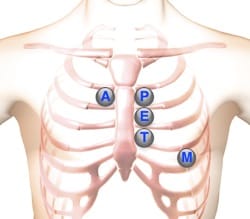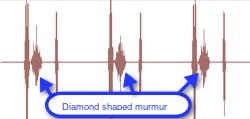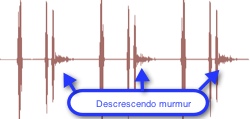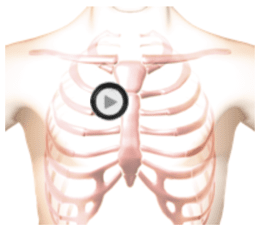Heart Murmurs
Heart Murmur Definition
Turbulent blood flow, particularly from the heart's valves, can generate heart murmurs. They can be found in infants or develop later in life. Pediatric innocent murmurs frequently resolve without treatment. Other heart murmurs can indicate a cardiac abnormality.
Heart Murmur Audio
This website uses both patient recordings and simulated heart sounds for training, drills and quizzes. Of course in real life you will use a stethoscope to auscultate. Normal heart sounds follow a "lub-DUB" pattern. The lub and dub are the sounds of your heart valves closing. In some abnormalities, the "lub-DUB" sound pattern changes with additional sounds being heard.
Cardiac Auscultation
On this website, we provide lessons, reference guides and quizzes for cardiac auscultation of murmurs and other heart sounds. This includes gaining an understanding of cardiac rate and rhythm, conditions of the valves and possible anatomical abnormalities such as congenital defects. Links to our lessons, guides and quizzes are found in the adjoining buttons.
Heart Murmur Sound Types
Heart sounds can include several types of sounds:
- The first heart sound (S1), cased by the closing of the mitral and tricuspid valve.
- The secound heart sound (S2), occuring with the closing of the aortic and pulmonary valve.
- An extra heart sound (S3). S3 occurs in a ventricular gallop. It is low-pitched sound that can follow S2.
- An extra heart sound (S4). S4 occurs in an atrial gallop. It is produced by the atria contraction that pushes blood into a stiff ventricle.
- Systolic sounds occur during the period between S1 and S2.
- Diastolic sounds occur between S2 and the beginning of the next heart beat.
- Clicksare short, higher-pitched sounds.
- Rubs are heard during systole with a leather-like sound quality..
Timing and Cadence
Timing is used to describe when murmurs occur within systole or diastole. For example, early systolic, midsystolic or late systolic.
Heart Sounds Location
Where To Listen To Heart Sounds
Heart sounds auscultation is usually taken over five locations on the anterior chest wall. Use the stethoscope's diaphragm, switching to the bell to hear lower pitched sounds.
Heart Murmur Location
In our lessons, we indicate the recommended auscultation location on the chest wall using both text and an icon on a thoracic illustration. Using these auscultation positions can help in evaluating the heart sound and its origin.

 |
Aortic Valve Area | Second right intercostal space (ICS), right sternal border | |
 |
Pulmonic Valve Area | Second left intercostal space (ICS), left sternal border | |
 |
Erb's Point | Third left ICS, left sternal border | |
 |
Tricuspid Valve Area | Fourth left ICS, left sternal border | |
 |
Mitral Valve Area | Fifth ICS, left mid-clavicular line |
Duration
Heart murmur duration refers to the portion of systole or diastole that the murmur occupies. Terms used include short and long. Murmurs lasting throughout systole are referred to as holosystolic or pansystolic.
Pitch
As you listen, try to make note of the sound's pitch. Is it low, medium or high frequency? The stethoscope bell should be used with low-pitched sounds and the diaphragm for medium or high-pitched sounds.
Shape
You may also read about additional sound patterns usch as crescendo (increasing intensity), decrescendo (decreasing intensity), crescendo-decrescendo (increasing then immediate decreasing intensity). Rectangular, also called plateau, refers to heart sounds of a steady sound volume. You can use our waveform videos to see these sound patterns are you listen to the heart sounds.


Tonal Quality
You should also listen for more sound qualities, such as musical, harsh, blowing, booming, sharp or dull.
Respiration and Patient Position
A patient's breathing and seated or lying position will incluence murmur sounds splitting. Our lesson will indicated preferred patient positions.

